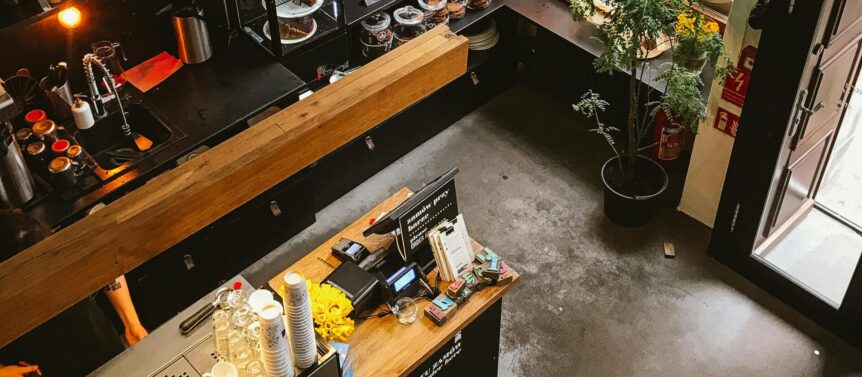
The Billion-Dollar Coffee Industry and… Retail Real Estate?
It’s no surprise that the coffee industry is a multibillion-dollar industry with over 2.25 billion cups of coffee being consumed daily. Coffee shops, often dubbed ‘third places,’ have evolved into spaces separate from work and home, creating connections and potentially communities. The roles of coffee shops in five cities in England, as explored in Ferreira et al.’s research, reveal that these spaces transcend mere consumption, serving as catalysts for connection in isolated urban lives, as we see it used for studying, working, and as an on the go beverage.

The COVID-19 pandemic has undoubtedly transformed the coffee industry, reshaping the way people perceive and enjoy their favorite brews. In the midst of this transformative period, Ferreira et al.’s examination of coffee shops in five cities in England becomes even more significant. With lockdowns and remote work becoming the new normal, the traditional appeal of coffee shops as social hubs for socializing, studying, and working has encountered obstacles.
At the same time, the economic repercussions of the pandemic, characterized by tight budgets and higher interest rates, have cast a shadow over entrepreneurial endeavors, including those in the coffee industry. The financial constraints have likely hindered fundraising for new ventures, impacting the ability of coffee enthusiasts to launch and sustain innovative coffee-related businesses. This economic backdrop adds a layer of complexity to the narrative, illustrating how external factors can influence the growth and adaptation of coffee shops as integral components of urban life, but with Build Central’s Delivery Zones you can map and compare major delivery services’ areas of operation nationwide, tracking the brands and people they serve, from grocery stores, ghost kitchens, restaurants, and QSRs to pharmacies and even pet care services.
What CosMc’s by McDonald’s means for the coffee and QSR industries
What is CosMc's McDonald's?
McDonald’s plans to launch a new chain called CosMc’s, which will emphasize coffee and other beverages, in a move seen as a direct challenge to Starbucks and Dunkin’. This expansion aims to bolster McDonald’s afternoon sales by catering to the growing demand for quality coffee and refreshments.
McDonald’s foray into the beverage-leaning Quick Service Restaurant (QSR) industry with CosMc’s marks a strategic shift. Joe Reinstein, Executive Director at the Digital Restaurant Association, suggests that McDonald’s is positioning itself as a direct competitor to Dunkin’ and Starbucks.
The coffee market’s robust growth, estimated at USD 132.13 billion in 2024, projects a compound annual growth rate (CAGR) of 4.72% by 2029. From the surge in demand for certified coffee products to the evolving trends in consumption, the coffee market shapes retail real estate dynamics to an outsized degree. Certified coffee products, sustainability, and ethical sourcing are driving factors, creating spaces that align with consumer values.
The profitability of the coffee industry has attracted the attention of celebrities, who go beyond their primary fields into the world of coffee. Notable names like Ralph Lauren, Leonardo DiCaprio, Rohan Marley, Tom Hanks, Hugh Jackman, and Emma Chamberlain have become part of this caffeinated wave.
Which celebrities have their own coffee brands?
Lyon Coffee – Leonardo DiCaprio Marley Coffee – Rohan Marley Chamberlain Coffee – Emma Chamberlain Laughing Man Coffee – Hugh Jackman
Ralph’s Coffee – Ralph Lauren

Lyon Coffee – Leonardo DiCaprio
Marley Coffee – Rohan Marley
Chamberlain Coffee – Emma Chamberlain
Laughing Man Coffee – Hugh Jackman
The pandemic disrupted many aspects of daily life, but coffee consumption persisted. Specialty blends, mobile ordering, and drive-through services specifically increased. Coffee shops, which are historically recession-resistant, adapted to changing times, investing in mobile ordering, takeaway, and drive-through offerings. According to Drive Research in 2024, 89% of coffee drinkers make it at home at least once a week and 51% of people purchase coffee from a coffee shop at least once a week.

(Geospex screenshot courtesy of Planned Retail of Starbucks in planning and under construction. There are 290 retailers and 2.2M sq footage of retail space.)
Are you ready for this? Proximity to a Starbucks has been linked to increased home values. Real estate broker Tatiana Londono notes that properties close to Starbucks appreciate faster, backed by a study showing a 0.5% increase in housing prices within a year of a new Starbucks introduction. The strategic approach of Starbucks in choosing locations based on demographics and growth potential contributes to this real estate quirk.
Using the median income tool from BuildCentral’s Planned Retail software we were able to see a trend in the placement of Starbucks being neighborhoods where the average income is above 60,000.

Selecting an ideal location for a coffee shop involves a comprehensive evaluation of various factors: demographic considerations, the assessment of foot traffic, visibility, and competition in the vicinity, proximity to local businesses, accessibility, and parking facilities which contribute to customer convenience. The aesthetic appeal and atmosphere of the location, aligned with the community’s character, are vital for attracting and retaining customers. Compliance with local regulations and zoning laws is essential, as well as leveraging technology for data-driven decisions, such as Starbucks’ use of Esri’s mapping software, and other places use of BuildCentral’s PlannedDevelopments which allows competition tracking and enhances strategic choices.
The billion-dollar coffee industry, with its diverse facets and far-reaching impacts, emerges as a pivotal player in retail real estate. From the evolution of coffee shops into community spaces to strategic moves by industry giants, and even the unexpected link between Starbucks and home values, the coffee narrative is one of growth, adaptation, and community building. As retail real estate stakeholders navigate this landscape, opportunities for innovation, sustainability, and community-driven spaces are dare I say… brewing.
Subscribe to the BuildCentral Newsletter to receive promos, feature updates, early project insights, growth tips, and more. Published once a month, we help you stay current on industry news, sales & marketing best practices and insights into top new projects and key players.
